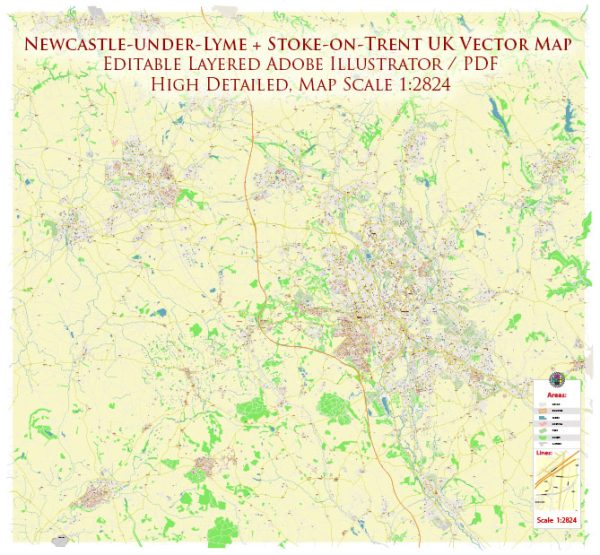Newcastle-under-Lyme and Stoke-on-Trent are two neighboring towns in Staffordshire, United Kingdom, each with its own distinct history of urban development.
Newcastle-under-Lyme:
- Medieval Origins: Newcastle-under-Lyme has medieval origins, with its market charter granted in 1173. The town’s name suggests a new castle was built during that period. The castle, unfortunately, no longer exists.
- Market Town: Throughout the medieval and early modern periods, Newcastle-under-Lyme thrived as a market town. Markets played a crucial role in its economic development, and the town’s layout reflects this, with a market square at its heart.
- Industrial Revolution: The Industrial Revolution had a significant impact on Newcastle-under-Lyme, as it did on many towns in the region. Industries such as silk weaving and coal mining became prominent, contributing to economic growth.
- Transportation: The town’s development was further influenced by transportation improvements. The construction of canals, such as the Trent and Mersey Canal, facilitated the movement of goods and connected Newcastle-under-Lyme to broader trade networks.
- Architecture: Architecturally, the town features a mix of medieval, Georgian, and Victorian buildings, showcasing its historical evolution. The Guildhall and St. Giles’ Church are notable landmarks.
Stoke-on-Trent:
- Potteries and Industrialization: Stoke-on-Trent is renowned for its association with the pottery industry. The town’s development was significantly shaped by the Industrial Revolution, with the emergence of numerous pottery factories along the Trent and Mersey Canal.
- The Six Towns: Stoke-on-Trent is often referred to as “The Potteries” and consists of six towns: Stoke, Hanley, Burslem, Tunstall, Longton, and Fenton. Each of these towns played a unique role in the pottery industry, contributing to the overall economic success of the region.
- Canals and Railways: Similar to Newcastle-under-Lyme, the town’s growth was facilitated by improved transportation. Canals and later railways became crucial for transporting raw materials and finished products.
- Urban Expansion: As the pottery industry flourished, the six towns experienced rapid urban expansion. The landscape became dotted with bottle kilns and industrial buildings.
- Cultural Heritage: Stoke-on-Trent has a rich cultural heritage linked to pottery. Museums like the Gladstone Pottery Museum preserve this history, providing insights into the manufacturing processes and the lives of the people involved.
Both Newcastle-under-Lyme and Stoke-on-Trent share a history shaped by industrialization, transportation developments, and the unique industries that defined their economic landscapes. Today, efforts to preserve and celebrate their historical heritage contribute to the identity of these towns.


 Author: Kirill Shrayber, Ph.D.
Author: Kirill Shrayber, Ph.D.